
Do you love Chinese Evergreen plants but are afraid you don’t have a green thumb? Worry no more because this blog post is perfect for you. You will learn how to water Chinese Evergreens, how to fertilize, how much light they need and everything else you need to know about Aglaonema care.
| Botanical Name (Latin Name/Scientific Name): | Aglaonema Commutatum |
| Common Name: | Chinese Evergreen |
| Light: | low light tolerant (50 Lux – 750+ lux) |
| Watering: | once the top half of the soil is dry |
| Soil: | well-draining mix |
| Repotting: | Once a year |
| Temperature: | 65°F to 75°F (18°C to 24°C) |
| Humidity: | 25% to 50%, but adapts well to any humidity |
| Toxicity for Pets: | Yes (pain and swelling of the tongue, mouth, and lips, drooling, vomiting, and difficulty swallowing) |
| Toxicity for Humans: | Yes (mouth, tongue, and throat irritations, throat swelling, breathing difficulties, burning pain, stomach upset, skin rash or irritation) |
| Propagation: |
|
| Pruning: | Prune dead or diseased growth or when you want the plant to branch out |
Light Requirements
| Minimal amount of light: | 50 Lux (5 FC) |
| Optimal amount of light: | 750+ lux (75+ FC) |
| Direct sun tolerance: | 1-2 hours |
| Category: | low light tolerant |
Chinese Evergreen is an extremely low-light tolerant plant, making it a popular choice for business premises, hotel hallways, etc. Therefore, it is the perfect low-light indoor plant. Even though it can tolerate low light, it will grow faster and be healthier if it gets a minimum of medium light. Medium light is light between 750 lux (75 FC) and 3000 lux (300 FC). Since a houseplant can never get too much indirect light, if you provide aglaonema with bright indirect light, the level of photosynthesis will be much higher, providing even faster growth and will have more leaves.
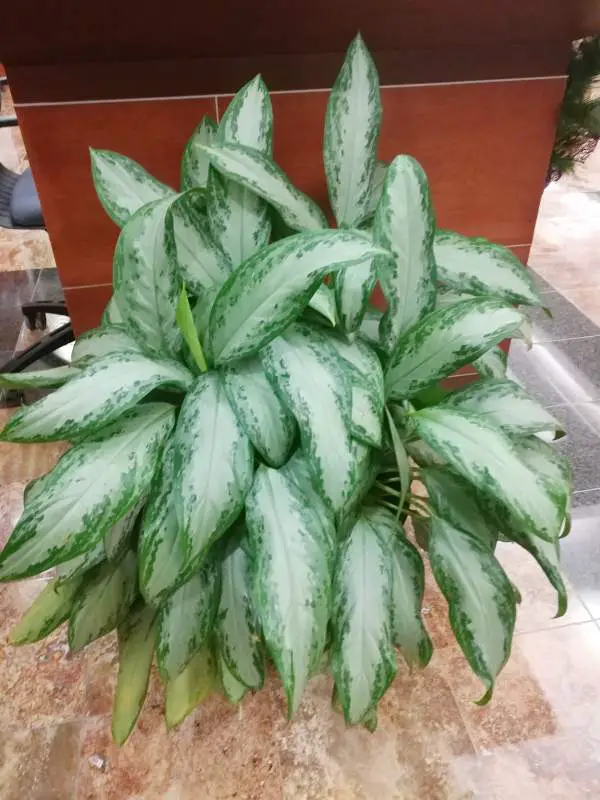
My office building is full of Chinese Evergreens
However, bear in mind that the Chinese Evergreen plant doesn’t tolerate direct sunlight for more than 1-2 hours (preferably early morning or late afternoon sun).
Water Needs
How often you should water your Chinese Evergreen depends greatly on its size. For smaller Chinese Evergreens, you should wait for the 1-2 inches of the top soil to dry out. For bigger plants, you should wait for the top half of the soil to dry out.
A Chinese Evergreen doesn’t tolerate staying dry for long. It also doesn’t like to be in wet soil all the time. So the trick is to find the right balance.
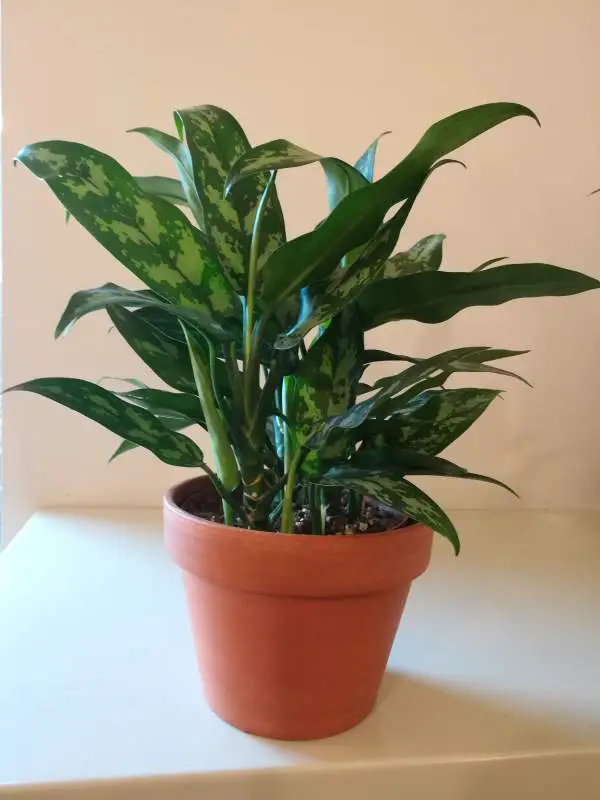
My Chinese Evergreen is growing
One of the easiest ways to check if your Chinese Evergreen needs watering is to stick a chopstick in the soil, all the way down. If it comes out without any traces of soil, it is time for some watering.
In addition, you’ll know your plant is thirsty when you notice that the leaves and stems become droopy. Still, you shouldn’t wait for this to happen as it stresses out your plant. Furthermore, the roots and the leaves can suffer damage if you wait too long.
Humidity Needs
A Chinese Evergreen plant has humidity needs ranging from 25% to 50%, but like most houseplant, it can also tolerate lower humidity. It won’t mind higher humidity either.
Temperature Requirements
Aglaonema requires temperatures between 65°F/18°C and 75°F /24°C. However, Chinese Evergreen can tolerate as low as 55°F/13°C, below which it can get chilling injuries. This is especially true for “Silver Queen.”
Fertilizing
Fertilizing Chinese Evergreen isn’t necessary, provided you repot it once a year. The new soil will provide all the nutrients. If you decide to fertilize, there are two things you must pay attention to:
- Never fertilize your plant in its dormant phase
- Always follow the instructions on the fertilizer package
Fertilizing Chinese Evergreen when it’s not actively growing isn’t recommended. Since the plant is not growing, fertilizing will lead to salt buildup which can burn the roots. If you want to fertilize your Chinese Evergreen, try using the Sill fertilizer. Why? Because it has an excellent N-P-K ratio of 9-3-6 that is great for foliage plants.
Soil
A Chinese Evergreen needs well-draining potting soil. You can buy potting mixes that are good straight-out-of-the-bag, like MotherEarth GroundSwell or you can make your own mix. It isn’t difficult at all.
If you decide to make your own mix, mix 2 parts all-purpose soil with 1 part perlite. Adding amendments with larger particles is essential because they create macro-pores that contain oxygen. This way, you can lower the risk of soil compaction and root rot.
Repotting
These are the steps to repotting a Chinese Evergreen:
- First, choose a one-size bigger pot than the current one
- Fill the pot one-third with well-draining potting soil.
- Gently take out the plant and, loosen the root ball
- Inspect the roots. If the roots are soft, mushy, smelly, they are rotten and need to be removed
- It’s time to put your plant in the new pot.
- Next, put your Chinese Evergreen in the middle and fill the pot with soil.
- Finally, press the soil lightly around your plant and water it.
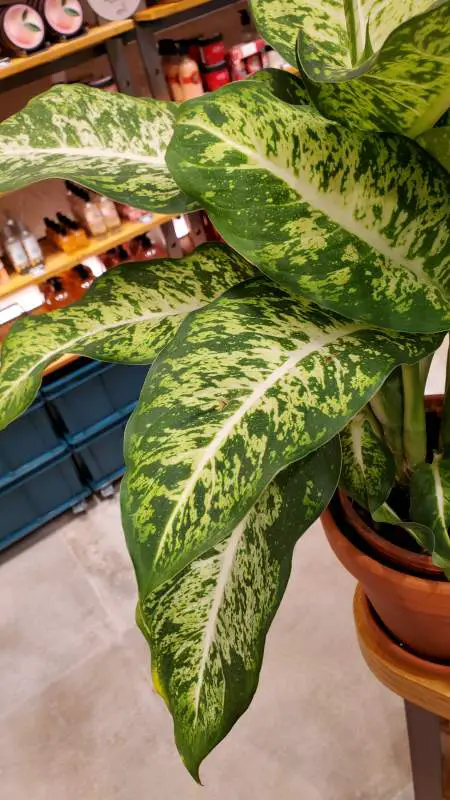
Chinese Evergreen ready to be repotted
Repotting Chinese Evergreen should take place when your plant has outgrown its pot, or at least annually. Over time the soil becomes nutrient deficient and it gets compacted, so it has less oxygen for the roots. When you repot, you are providing fresh, nutrient-rich soil. And you are also providing new, non-compacted soil.
Toxicity To Humans
Chinese Evergreen is toxic to humans. Ann King Filmer, Ph.D. Plant Scientist from the University of California, in the publication “Safe and Poisonous Garden Plants” from October 2012 states that this plant can cause mouth, tongue, and throat irritations that can result in throat swelling, breathing difficulties, burning pain, and stomach upset. Also, thorns, sap, or juice of this plant can cause a skin rash or irritation.
Toxicity To Pets
Chinese Evergreen is toxic to pets. The American Society For The Prevention Of Cruelty To Animals (ASPCA) confirms that this plant contains calcium oxalates and it can cause various problems such as pain and swelling of the tongue, mouth, and lips, drooling, vomiting, and difficulty swallowing.
Pruning
Pruning Aglaonema Chinese Evergreen isn’t necessary if the plant is healthy. On the other hand, pruning is necessary when a part of the plant is sick, dying, or dead.
Propagation
You can do Chinese Evergreen propagation in a few ways:
- division – division refers to dividing a pot with several plants into separate pots, each with at least one plant.
- tip or stem propagation – you cut a stem then propagate it in soil or water.
- cane cuttings – you cut a stem/cane into several segments and lay them flat on soil. Each cane cutting will grow into a separate plant
For the stem propagation method in water, take a cutting and place it in a propagation vessel in bright indirect light. Replace the water once a week or more frequently if it gets dirty. One of the main reasons you should change the water regularly is because the PH value of the water changes over time, affecting the plant’s absorption of nutrients. The amount of oxygen also goes down and roots need oxygen for growth
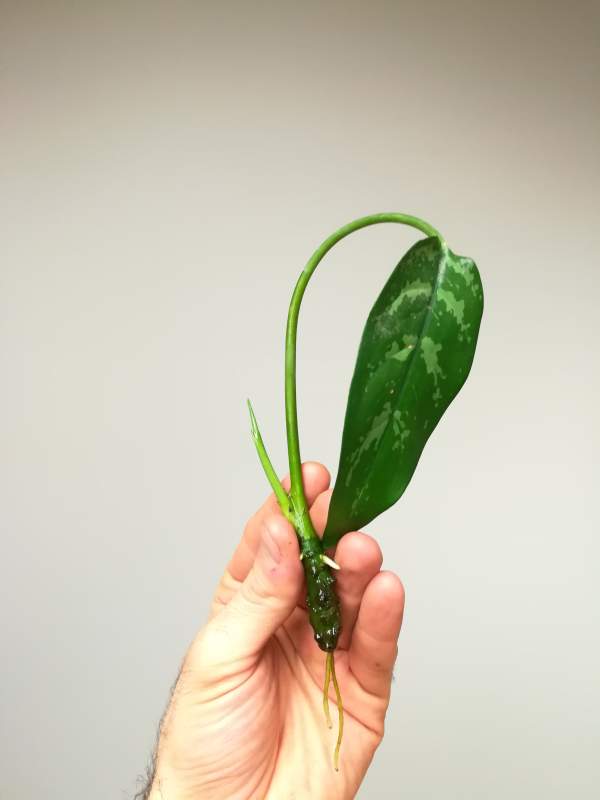
My Chinese water-propagated Evergreen putting out a new shoot
If you want to see the process of potting a water-propagated Chinese Evergreen, check out the video below.
Although Chinese Evergreen can be propagated in a few ways, leaf propagation isn’t one of them.
FAQs about Chinese Evergreen
Do Chinese Evergreens Flower?
Yes, Chinese Evergreens flower. Aglaonemas are aroids (plants in the Araceae family), and these flowers are a distinguishing feature of all aroids. In order for the plant to flower, it needs to get a good amount of light, at least 5,000 lux (500FC on average)
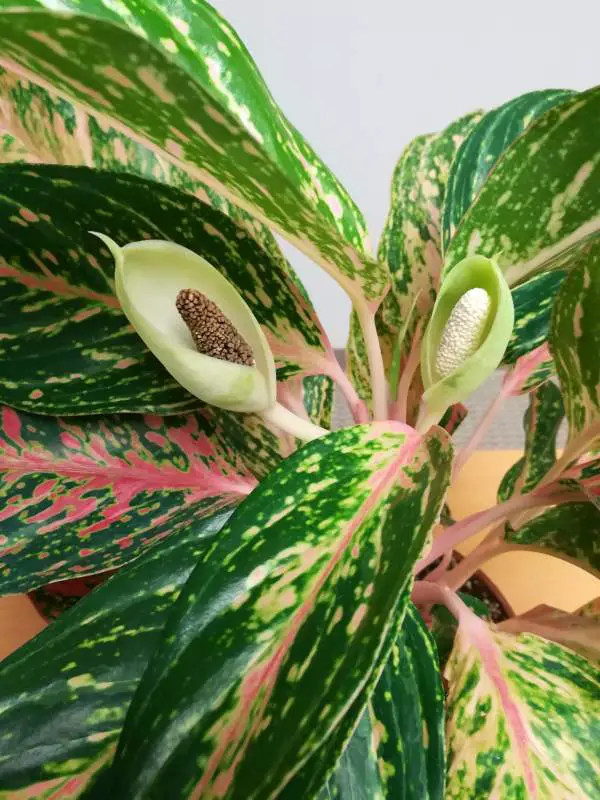
Mr. Houseplant’s Chinese Evergreen has flowered
How Big Does a Chinese Evergreen Get?
Chinese Evergreen can get up to 40 inches tall.
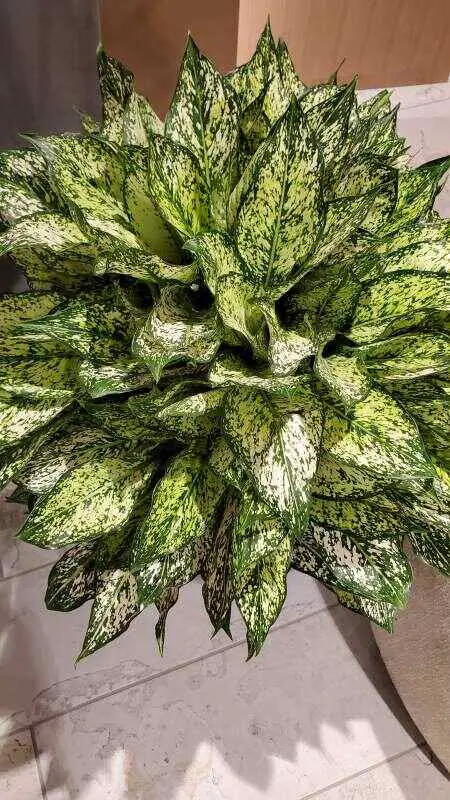
Mr. Houseplant's gorgeous Chinese Evergreen
Why is my Chinese Evergreen Turning Yellow?
There could be multiple reasons why your Chinese Evergreen is turning yellow. The most common culprits are normal leaf loss (senescence), underwatering or overwatering, pests or diseases.
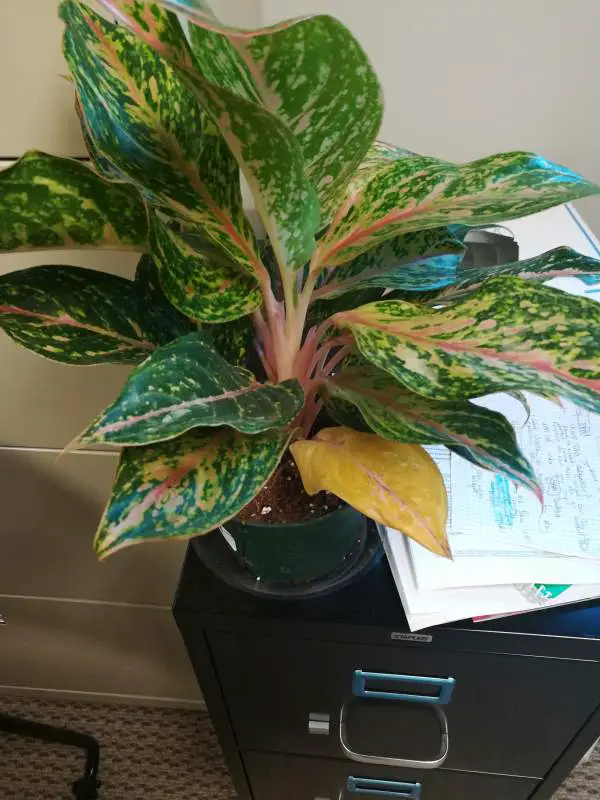
Yellow leaves on my Chinese Evergreen Plant
What Types of Chinese Evergreen are There?
There are 21 types of Chinese Evergreen. Some of the more popular cultivars are:
- Silver Queen with green and silver stripes. It is also one of the most temperature-sensitive ones.
- San Remo, the darkest Aglanomea in terms of color
- Silver Bay has a more oval leaf shape compared to other cultivars
- Patricia has spiky leaves and silver leaves.
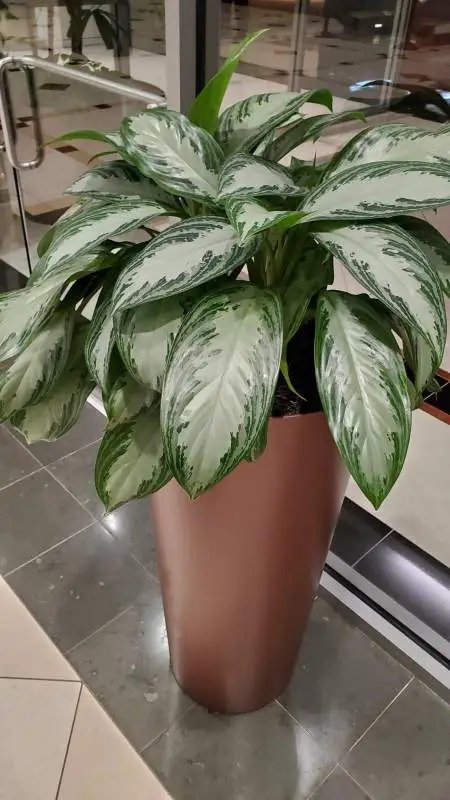
Silver Bay in the hall of a hotel
No matter which cultivar you have, the fact remains that Chinese Evergreen care is quite hassle-free, which makes Chinese Evergreen one of the most popular houseplants.
Are Chinese Evergreens Only Indoor Plants?
No, Chinese Evergreens aren’t only indoor plants. Although they thrive in low light indoors, you can keep them outside. All plants naturally grow outdoors, we are the ones who brought them inside. If you grow your plant outside, make sure to keep it in shade and not expose it to direct sunlight.
If you can’t provide indirect light, then you can expose Chinese Evergreens to a bit of early morning or late afternoon sun. But even then, don’t expose them for more than 2 hours, as it can get sunburned.
Due to its low-light requirements, the Chinese Evergreen is an easy-going and easy to care for plant, which makes it a perfect plant for beginner plant parents.
If you have any more questions regarding Chinese Evergreen plant care or houseplants in general, feel free to schedule a virtual houseplant consultation with me and get the help you need.
Always happy to help!
Yours Truly,



Related Posts
Sansevieria Black Gold (Snake Plant Care GUIDE!)
Spathiphyllum Sensation (FULLY Explained!)
Alocasia Stingray Care